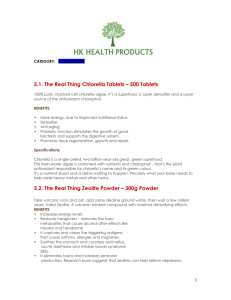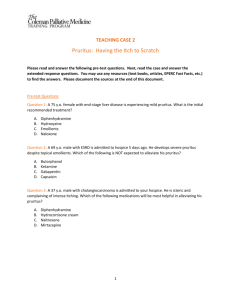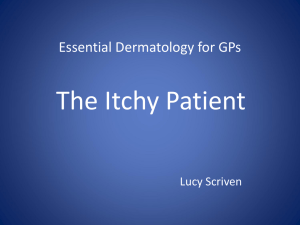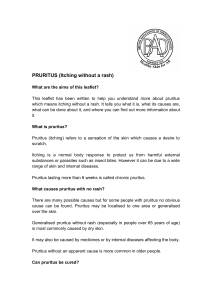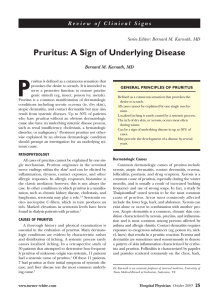treated with zeolite products
advertisement
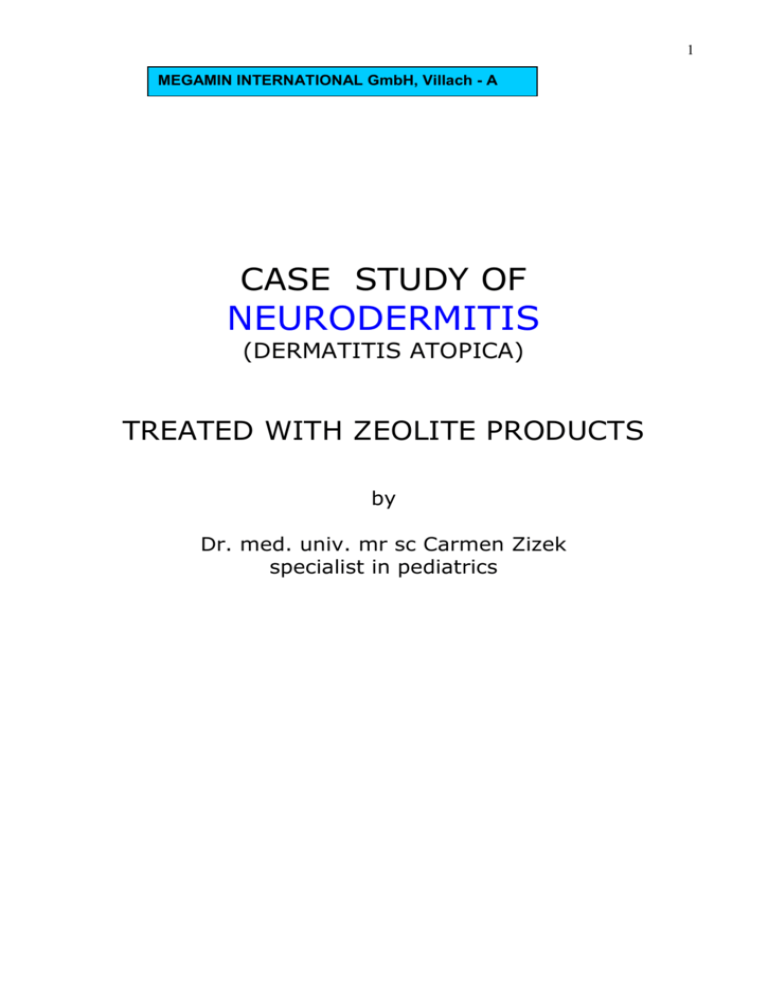
1 MEGAMIN INTERNATIONAL GmbH, Villach - A CASE STUDY OF NEURODERMITIS (DERMATITIS ATOPICA) TREATED WITH ZEOLITE PRODUCTS by Dr. med. univ. mr sc Carmen Zizek specialist in pediatrics 2 INTRODUCTION Latin names of dermatitis atopica (AD in further text), like eczema infantum, neurodermitis, pruridermatitis allergica chronica constitutionalis Kogoj, are used. Disease with dominant recidival chronical inflamation of the skin starts usually very early, after delivery and continues in a childhood. It is usually joined with other allergic disease of child or hereditary present in a family. Neurodermitis appears in 95% of cases beore 4.th year, with first manifestations between 1-4th month of life. Clinical manifestation starts with a tiny eflorescencia like eryitema and red papulas with a strong impact of pruritus and discomfort, which leads to scratching with ecscoriation and bleeding of the skin. Tipical locations are on face, around the ears, back of head, occipital, pelvic region, extremitas (knees and elbows especially extensiors side. In some havy cases, proces can be spread over the all body. Vet manifestations on skin like vesikulas and pustulas and later appearance of crusts lead to secondary infection (bacterial, viral, rarely fungal). Manifestations on the skin show chronical progresion, lihenificated papulas mainly localised on joints, pelvic region, on neck, or diseminated. Pruritus often makes situation worse with traumatic bleeding and erosions of the skin which havilly disturb a good mud and sleeping. When signs of respiration alergy (asthma) occure, the situation becomes worse and worse. Later in adolescent faze and after, neurodermitis is present in latent form or more often recidival manifestations occure. Tipical locations of recidival dermatitis are present on flexuras or in front of lower leg or nuchal few lichenificated centers. Skin lesions can be located only on eyebrows and that could be the only clinic sign of the disease. PATOGENESIS It is not yet comletelly explained. There are few hypotesis which are trying to describe the causes of this illness. Today, one theory is mostly accepted: *allergic-immune mechanism which explains the disturbance in production of antibody (IgE, IgG4, IgA) and cell immunity. Importance of feeding in postnatal period is today of great interest in therapy, because some of the nutritive agents are considered as a 'strong alergens' like proteins of a natural milk and eggs, in relationship with the skin manifestations. Varios conservans and aditives, perorally taken drugs, inhalatory alergens are now the often subject of investigation. *Transepidermal way is also described but can not always be explained as a cause of neurodermitis because the IgE antibody can not be approved in 20-40% of cases (Buscino and all). *The other hipotesis like this which includes abnormality of beta-adrenergic receptors can not explain complete patogenesis of disease. Important role in patogenesis, which is accepted today, plays the function of Langerhans cells, which is the important factor in immune system. This cells, are members of macrofagmonocites, have the role in intracelular way of superficial antigens. Pancreatic cells carry CD1 i CD4 antigens and also Fc receptors for IgE and C3b. Beside this cells, like in a different allergic reactions, mastocites in skin release histamin which leads to eritema and pruritus (Ruzicka and all, 1983.) But, manifestations of neurodermitis can not be entirely explained knowing the actions of all mediators (primary-histamin, secondary-prostaglandines, leucotriens or fragments of complements which can with a stimulation of immune complexes, cause the release of histamin). Beside the mastocites, beta cells and IgE, lymphocites T also recognise the antigen. There is no evidence, also, that tisue hysto-campatible gens are here of great importance here, like in psoriasis (Bruijnzeel-Koomen and all, 1990.). Changes in postnatal faze can be explained with a fact of increase increased diffusion of antigen through mucouse membrane because the shortage of IgA. 3 Pruritus with a skin changes depend not only of histamin, but prostaglandines and neuro peptides, there are also separate neurotransmiter-receptors for pruritus! (Hagemark, 1989.) DIAGNOSIS Diagnosis of neurodermitis is concluded based on clinical and laboratory findings. It is also known that at least threee changes of the skin must be reported that a final dignosis can be pronounced. For example: dry skin – xerosis, generalised form or present on limbs; clinical findings of ihtiosis vulgaris with a dry palms of the hands and soles of the foot ; keratosis piliaris with tiny folicular spots on the body and extensors part of limbs. Early reactivity in skin test, increased values complete and specific IgE in serum are characteristic changes, decreased IgA in serum and excretory liquids, decreased celular immunity with outside manifestations with pallor and erytema of a face, infraorbital furrow, signs of enviromental and emotional addiction factors, paradoxal vaso-constrictorial reaction, white dermografitism on kolinergic agens (Buscino, 1983. Puretić 1987.) Laboratory findings are not patognomonical, so final diagnosis is given after positive clinical findings and anamnesis. In some cases, periferal blood can show increased eosinofiles, rarely extremly high. In most of the cases level of IgG4, subpopulation of T lymphocites, cellular immunity are important and should be measured. In infants we can find intermitent insuficiency of IgA. Hysto-patological findings are specific in acute and chronic faze. Increased number of Langerhans cells are significant and typical (usually 3-8%), fagocites and mastocites. Test of cutis can not be performed in all patients. THERAPY Treatment of skin with neutral kream or emulsions (Croatian products Bekutan, Lekobaza etc.). Patient should be avoid shower, exposing to the sun and wind because of dry skin. Bath in a sea is usefull. Food with some alergens should be avoid also esspecially in the first period (natural cow milk, white part of egg, lemons products) in infants, so food with protein hydrolisats like Nutramigen, Pregestemil, or evaporised cow milk are recommended. Prolonged nourishment delays the begining of AD and probably protect infants (Kajossari). Hiposensibilization should be performed. Havy cases of neurodermitis are treated with korticosteroides with antihistaminics. Profilaksis should be performed with long term giving of cromoglicates disodium or ketotifen. The results are partial and questionable. RESULTS OF TREATMENT WITH ZEOLITE products In prospective study we included five children from 1-5 years old with a verified diagnosis. In this study we will describe the case of female I.M. 5 years old. From anamnesis: positive anamnesis (older brother has asthma), lower values IgGA in 4th month of life, CAP IgE 6,11kU7L, positive skin allergic test on D.Pteronissimus, functional immunological tests showed low CD4 in lymphocite proliferation of peripheral blood. D.pt.Extreme high 100.00 IU7mlRAST Class. Specific IgE in 3th year increased to 1557,40 IJ/ml (referent value <20IJ/ml). Recidival bronch-opstructive attacs present every month in period of 3 years. Dg: ASTHMA BRONCHIALE NEURODERMITIS CHR. 4 Girl is treated with Salbutamol, Teofilin, korticosteroid with FO parenteral way, Ketotifen in profilaksis, because of havy attacs of bronchoopstructions. Skin manifestations, pruritus, excoriations and superinfections are treated with Geocorton, Hydrocortison, Belobaza. Emotionaly and socially totally changed. Excluded from scool enviroment, child became associal, nervous almost autoagresive and destructive. Great attacs of pruritus were havy in spite of aplication of Oxetal and other histaminics. The child came to me in a faze (amateur photos in addition) when atrophy of skin with ragades has started, hirsutism on back, in a serious and havy clinical condition. She was included in prospective study of local and peroral treatment and with zeolite – cream and powder with peroral taking 3x2-3tbl a 600mg of zeolite clinoptilolite. Local remision of skin occured in a first month of treatment. Excoriations disappeared, with a loss of pruritus in great measure, child sleeps peacefully, returned to collective, emotionaly stable and warm in behaviour, returned to it's normal life. Good condition of child continued for 6 month, with same doses of zeolite. In this period attacs of recidival opstructive bronchitis stoped, skin became entirely elastic, smooth, hydrofobic, with no signs of pigmentation. During this period there was no need for aplication of korticosteroides, antihistaminic drugs, and mother reduced giving Ketotifen by her decideon. Laboratory findings, functional immun tests, specific IgE, electrophoresis T lymphocites. CONCLUSION 5 cases of neurodermitis are in the middle of treatment with zeolite products: suspension or cream or powder, localy and peroraly with tabl. or caps a 600mg in a doses depend on weight. Clinical findings in all cases showed significant improvement almost the same as girl M.I. described in this study. We must underline that most of this litle patients are treated only with zeolite products, which avoid clasical havy, dangerous and toxic therapy. 5 6 7 8


